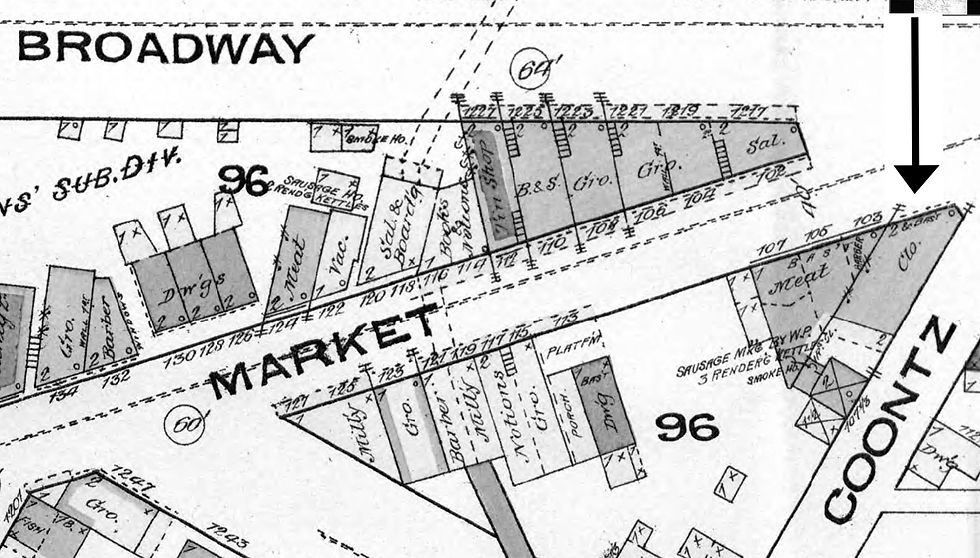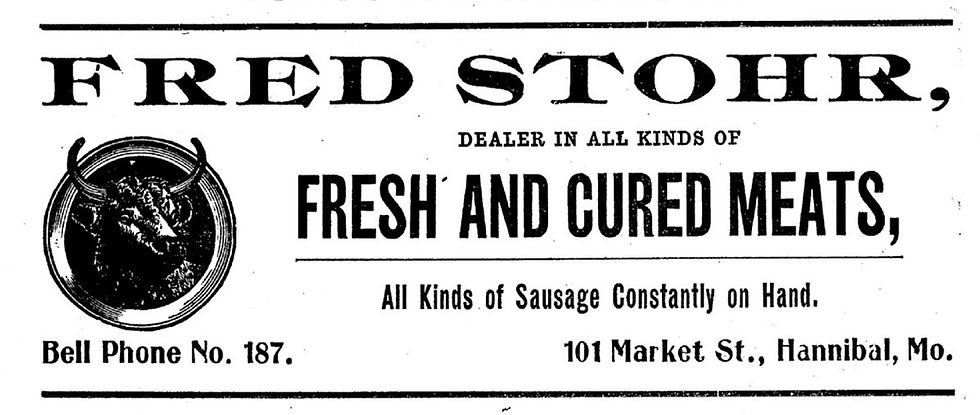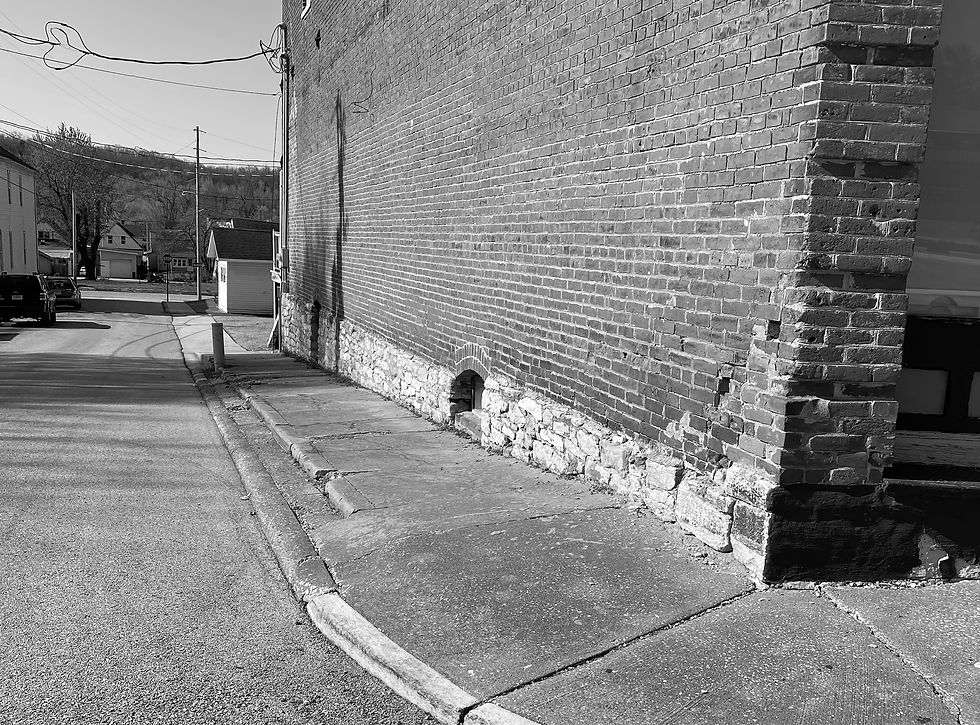Hannibal butcher just couldn’t catch a break
- Mary Lou Montgomery
- Jan 26, 2023
- 6 min read

This photo of the building at the corner of Coontz and Market Streets (now numbered 1221 Market Street, Hannibal, Mo.) was taken in April 2022. The building has housed a number of businesses throughout its history, pre-1885, and today is home to White Oak Counseling. The building is owned by Mark and Carrie Shields-Danner. Photo by Mary Lou Montgomery
MARY LOU MONTGOMERY
Fred Stohr, working as a meat cutter in Hannibal as early as 1873, had a number of setbacks during his business years including:
His wife’s death in 1897; and
a devastating fire in 1899.
He continued to push forward, however, working from pre-dawn until past dusk, in order to recover from his losses and provide for his young family.
Despite his hard work, however, lady luck just wasn’t on his side.
German born
Fred Stohr, born in Germany, came to the United States in 1864, ultimately settling in Hannibal. He worked for a German butcher, Charles Scherz, as early as 1873, and by 1875 Stohr was honing his trade under the guidance of Edward T. Bridgeford at 411 Broadway. By 1877, he had forged out on his own, operating a meat market at stall No. 11, at Hannibal’s Market House.
That same year he took for his bride Miss Louisa Schultz, and over the course of the next decade and a half, they brought four children into the world, William, Lula, Edna and Helen.
Tragically, when the youngest of his children was just 2, on Oct. 19, 1897, Mrs. Stohr died of typhoid fever, at the age of 40.
She was laid to rest at Mount Olivet Cemetery. Fred Stohr hired a housekeeper to help with the children, including at one time Miss Phebe A. Sullivan.
Business growth
As 1898 closed and 1899 began, Fred Stohr had expanded his holdings to include the operation of a slaughter house and cold storage plant near the MK&T Outer Depot in Oakwood, nearby to George Cameron’s pastureland.
In his employ at this time were more than a half dozen men, each supporting a family by earning wages in various capacities surrounding the meat packing industry. Those men included Louis C. Rich, driver; Oscar N. Owens, bookkeeper; Charles Lavoo, driver; J. George Kaiser, butcher; Nicholas P. Dietrich, engineer; and Leon DeLaPorte, butcher.
Stohr did business with local farmers, purchasing cows and hogs from the likes of John Kruse, H. Pieter of West Ely, and Mr. Cummings.
But all business came to a standstill on the morning of Jan. 4, 1899, when the entire slaughter house and cold storage plant was reduced to ashes, thought to be the work of an incendiary.
While there was insurance on the property, it wasn’t enough to replace the economic impact of a thriving business. By 1901, Fred Stohr was back to where he had been a decade prior: Operating a one-man butcher shop, this time in the small corner building that he owned, at 101 Market Street.
His employees found other job opportunities after the fire. In 1901/1903, Louis C. Rich worked as a carpenter; Oscar N. Owens, bookkeeper for the Hannibal Door and Sash Company; Charles Lavoo, working as a fireman; J. George Kaiser, operating his own meat market at 107 Market; Nicholas P. Dietrich, working for Herl Brewery; and Leon DeLaPorte, clerk for C.P. Scherz, butcher.
Marriage
At the end of June, 1900, Fred Stohr took for his second wife Catharine Scherz, younger sister of the aforementioned Charles Scherz, with whom he worked in the 1870s.
Memories of the Stohr-Scherz marriage linger, thanks in part to an interview conducted by Bev Darr, published in the Hannibal Courier-Post on Dec. 19, 1998. The occasion was the 103rd birthday of Helen Stohr Roesler, the youngest of Fred Stohr’s daughters. Mrs. Roesler shared the story of her early childhood in Hannibal.
She was born in an upstairs apartment over her father’s meat market, at 101 Market. When she was 2, her mother died, and when she was 4, her father married Catharine Scherz, daughter of Andrew and Julia Scherz.
“She was a woman he had dated years earlier, who had never married. Catherine told people ‘I didn't want him when he didn't have any children, and when he had four children, I took him.’
A fond memory Helen shared: ”We were having cherries for supper, and I wouldn't ask my stepmother for them. I didn't know her well enough. I asked my sister.”
Rebuilding after the fire
During the next five years after the fire, Fred Stohr worked to rebuild his financial standing in the community. He served the Fifth Ward on the Hannibal City Council. He and his family moved from the apartment above the meat market at 101 Market, to the home of his new wife, at 111 and later 115 London (South Arch). He sold the business building at the corner of Market and Coontz streets to Emmet V. Settles in 1904, but maintained his meat market at 101 Market.
Son’s death
William Stohr, the only son of Fred Stohr, died at the age of 17, according to Helen Stohr Roesler.
Final tragedy
Just as he was getting his financial affairs in order after the devastating fire, tragedy struck again. The June 28, 1905 edition of the Quincy Daily Journal told the story.
After a brisk morning trade, Mr. Stohr’s supply of meat behind the counter was diminished. At 3 o’clock, when there were no customers in the store, he went to the refrigerator to take down a piece of meat, from which he planned to cut some roasts preparatory to the afternoon trade.
“He took with him as usual his cutting knife, and holding it in one hand he reached up with the other to unhook a piece of meat. The floor of the ice box, or refrigerator, was very slippery and he slipped and fell in such a manner that the knife, which was as keen as a razor, struck him in the throat and severed the jugular artery, from which he bled to death in a very short time.”
The next customer to enter the store was Capt. Thomas Curtis Lippencott (1834-1913) introduced in last week’s story).
Capt. Lippencott “saw Mr. Stohr in the ice box in a half sitting position, almost covered with blood and the bloody knife lying by his side. When the doctors arrived the man was dead. Upon examination it was found that the knife had penetrated his throat to the depth of about 3 inches and one inch across, so that death was almost instantaneous in fact, the indications were that he never made a struggle after he fell.”
Keeping family together
Helen Stohr, who was 9 at the time of her father’s death, said that her stepmother "kept all of us and reared us. She was a good stepmother.”
The daughters attended St. John Lutheran School, after which Helen went to Eugene Field through ninth grade. Her step-mother told her she couldn’t go to the high school, because there wasn’t enough money.
Instead, the daughters, each in turn, obtained commercial training and held responsible jobs in the community. Lula worked as a stenographer for W.T. League in 1907; Edna worked as a stenographer for Rendlen Liquor Company in 1911; and in 1912, Helen worked as a stenographer for the Hannibal National Fire Company.
When Catherine Stohr died in 1917, she left her home to her three step daughters. She is buried at Mount Olivet Cemetery.

The arrow points to a two-story building (with basement) located at the intersection of Coontz and Market streets. This Sanborn map from 1885 shows the location of the building which, well into the 20th Century, was one of Hannibal’s most important business houses. For more than 20 years, the building was owned by Fred Stohr, one of Hannibal’s most prominent butchers. In 1904, he sold the building to E.V. Settles, but continued to operate his meat market on the building’s first floor.

Fred Stohr advertised his meat market, located at 101 Market (later renumbered 1221 Market) in the 1903 Hannibal City Directory. Directories are accessible online via the Hannibal Free Public Library’s website.

Fred Stohr’s meat market at 101 Market (later renumbered 1221 Market) was advertised in the 1905 Hannibal City Directory. Directories are accessible online via the Hannibal Free Public Library’s website.

Pictured is Coontz Street, going south. The building at left was constructed prior to 1885. Note that the foundation is made of stone; typical of that era. The address of this building was once 101 Market Street. Today it is numbered 1221 Market St., Hannibal, Mo. Photo by Mary Lou Montgomery
Note: Archie Hayden describes the location of the MK&T Outer Depot as where Owens Street intersects with Warren Barrett Drive.
Mary Lou Montgomery, retired as editor of the Hannibal (Mo.) Courier-Post in 2014. She researches and writes narrative-style stories about the people who served as building blocks for this region’s foundation. Books available on Amazon.com by this author include but are not limited to: "The Notorious Madam Shaw," "Pioneers in Medicine from Northeast Missouri," "The Historic Murphy House, Hannibal, Mo., Circa 1870,” and “Hannibal’s ‘West End,’” 47 stories of the Market Street Wedge and on west to Lindell Avenue. Montgomery can be reached at Montgomery.editor@yahoo.com Her collective works can be found at www.maryloumontgomery.com


























Comments